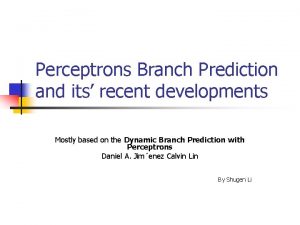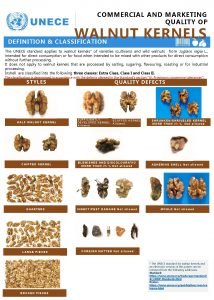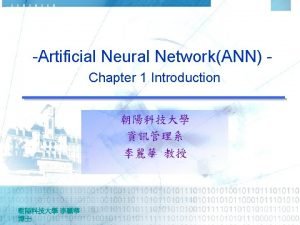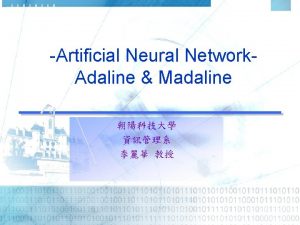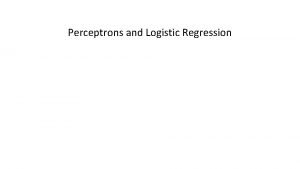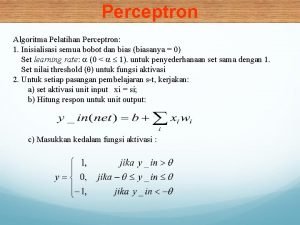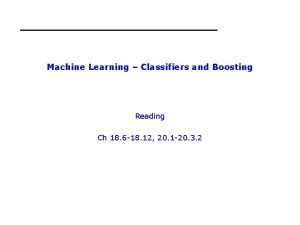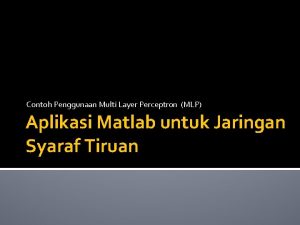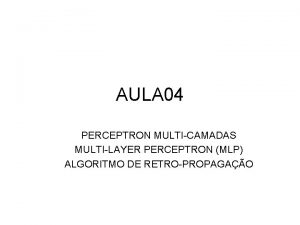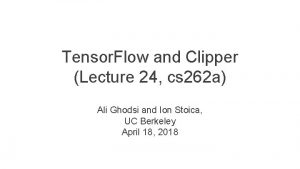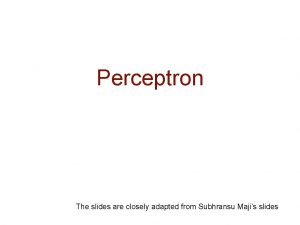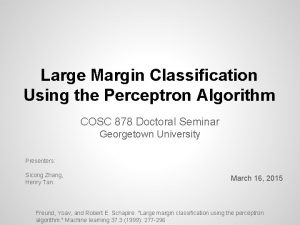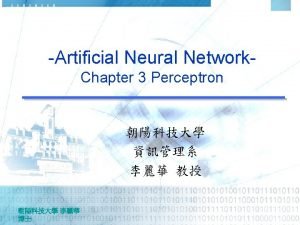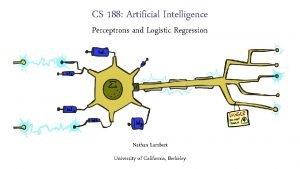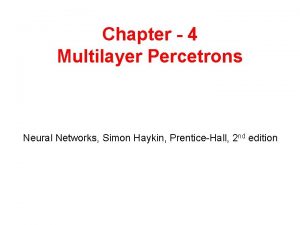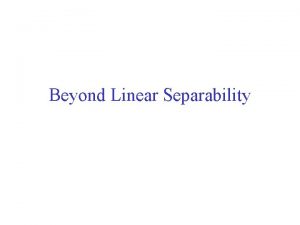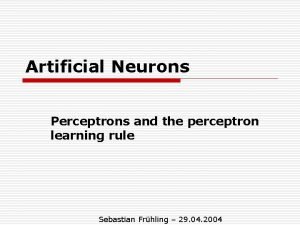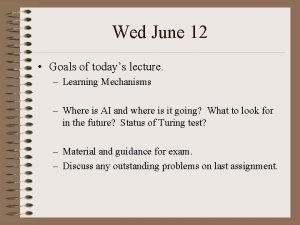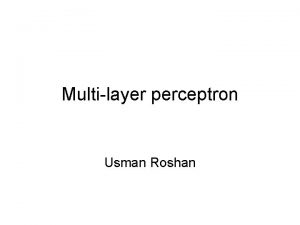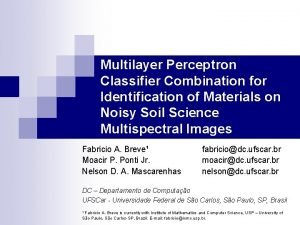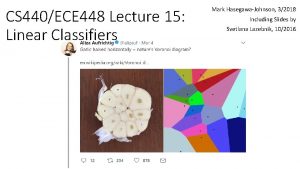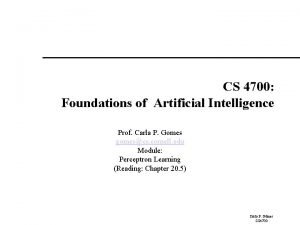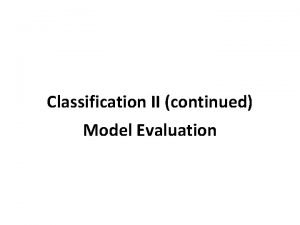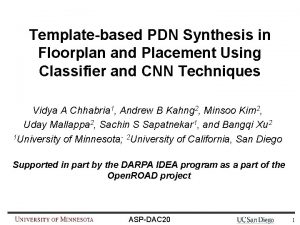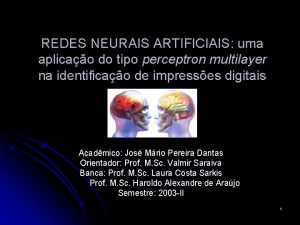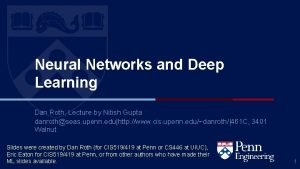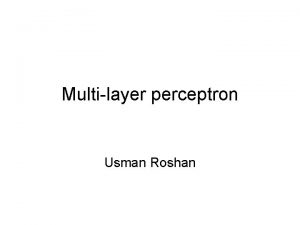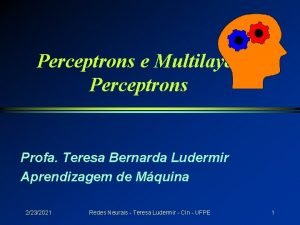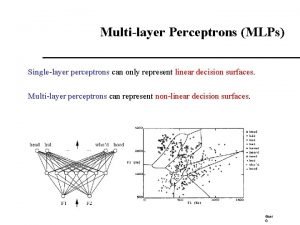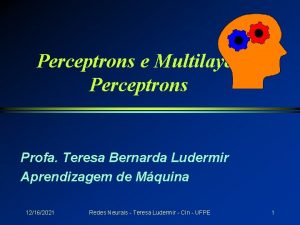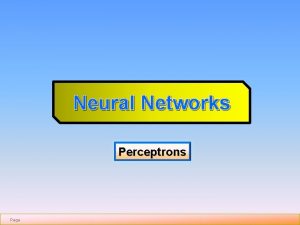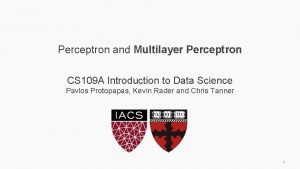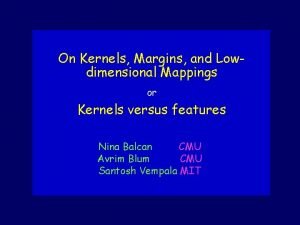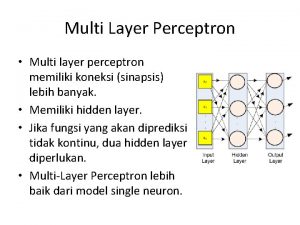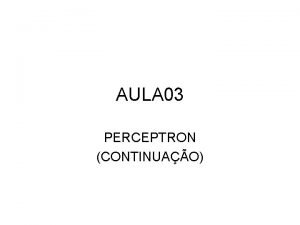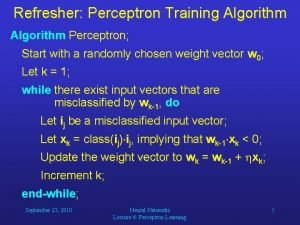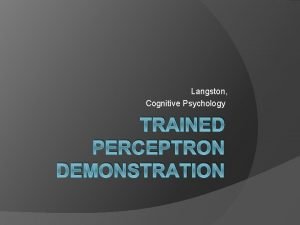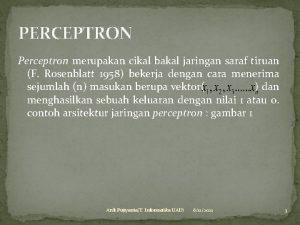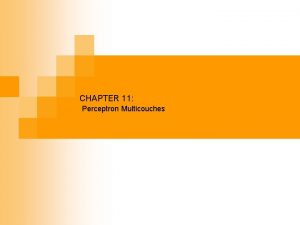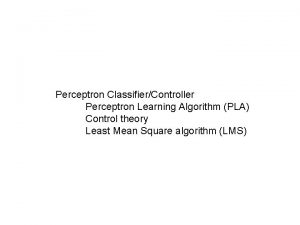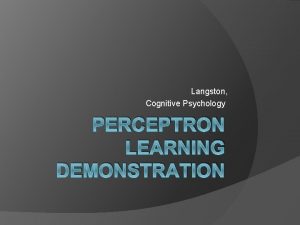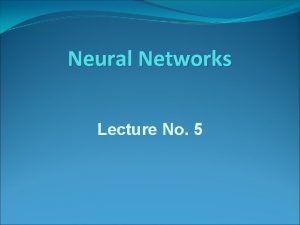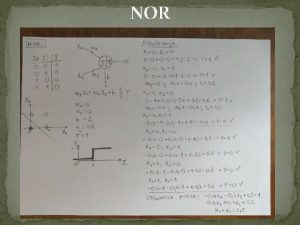KERNELS AND PERCEPTRONS The perceptron x is a








































- Slides: 40

KERNELS AND PERCEPTRONS

The perceptron x is a vector y is -1 or +1 instance xi A B ^ yi ^ Compute: yi = sign(vk. xi ) If mistake: vk+1 = vk + yi xi yi u Depends on how easy the learning problem is, not dimension of vectors x +x 2 v 2 >γ Fairly intuitive: • “Similarity” of v to u looks like (v. u)/|v. v| • (v. u) grows by >= γafter mistake • (v. v) grows by <= R 2 v 1 -u 2γ 2

The kernel perceptron A instance xi B ^ yi yi ^ Compute: yi = sign(vk. xi ) If mistake: vk+1 = vk + yi xi Mathematically the same as before … but allows use of the kernel trick 3

The kernel perceptron A instance xi B ^ yi yi ^ Compute: yi = vk. xi If mistake: vk+1 = vk + yi xi Mathematically the same as before … but allows use of the “kernel trick” Other kernel methods (SVM, Gaussian processes) aren’t constrained to limited set (+1/-1/0) of weights on the K(x, v) values. 4

Some common kernels • Linear kernel: • Polynomial kernel: • Gaussian kernel: • More later…. 5

Kernels 101 • Duality – and computational properties – Reproducing Kernel Hilbert Space (RKHS) • Gram matrix • Positive semi-definite • Closure properties 6

Explicitly map from x to φ(x) – i. e. to the point corresponding to x in the Hilbert space Kernels 101 Implicitly map from x to φ(x) by changing the kernel function K • Duality: two ways to look at this Two different computational ways of getting the same behavior 7

Kernels 101 • Duality • Gram matrix: K(x, x’) = K(x’, x) Gram matrix is symmetric K: kij = K(xi, xj) 8

Kernels 101 • Duality • Gram matrix: K: kij = K(xi, xj) K(x, x’) = K(x’, x) Gram matrix is symmetric K is “positive semi-definite” … z. T K z >= 0 for all z Fun fact: Gram matrix positive semi-definite K(xi, xj)=φ(xi), φ(xj) for some φ Proof: φ(x) uses the eigenvectors of K to represent x 9

HASH KERNELS AND “THE HASH TRICK” 10

Question • Most of the weights in a classifier are – small and not important – So we can use the “hash trick” 11

12

The hash trick as a kernel • Usually we implicitly map from x to φ(x) – All computations of learner are in terms of K(x, x’) = <φ(x), φ(x’) > – Because φ(x) is large • In this case we explicitly map from x to φ(x) – φ(x) is small

Some details Slightly different hash to avoid systematic bias m is the number of buckets you hash into (R in my discussion) 14

Some details Slightly different hash to avoid systematic bias m is the number of buckets you hash into (R in my discussion) 15

Some details I. e. – a hashed vector is probably close to the original vector 16

Some details I. e. the inner products between x and x’ are probably not changed too much by the hash function: a classifier will probably still work 17

Some details 18

The hash kernel: implementation • One problem: debugging is harder – Features are no longer meaningful – There’s a new way to ruin a classifier • Change the hash function • You can separately compute the set of all words that hash to h and guess what features mean – Build an inverted index h w 1, w 2, …, 19

ADAPTIVE GRADIENTS

Motivation • What’s the best learning rate? – If a feature is rare, but relevant, it should be high, else learning will be slow • Regularization makes this better/worse? – But then you could overshoot the local minima when you train

Motivation • What’s the best learning rate? – Depends on typical gradient for a feature • Small fast rate • Large slow rate – Sadly we can’t afford to ignore rare features • We could have a lot of them

Motivation • What’s the best learning rate? – Let’s pretend our observed gradients are from a zero-mean Gaussian and find variances, then scale dimension j by sd(j)-1

Motivation • What’s the best learning rate? – Let’s pretend our observed gradients are from a zero-mean Gaussian and find variances, then scale dimension j by sd(j)-1 – Ignore co-variances for efficiency

Motivation • What’s the best learning rate? – Let’s pretend our observed gradients are from a zero-mean Gaussian and find variances, then scale dimension j by sd(j)-1 – Ignore co-variances for efficiency

Adagrad Gradient at time τcovariances η= 1 is usually ok

ALL-REDUCE

Introduction • Common pattern: – do some learning in parallel MAP – aggregate local changes from each processor • to shared parameters – distribute the new shared parameters ALLREDUCE • back to each processor – and repeat…. • All. Reduce implemented in MPI, recently in VW code (John Langford) in a Hadoop/compatible scheme







Gory details of VW Hadoop-All. Reduce • Spanning-tree server: – Separate process constructs a spanning tree of the compute nodes in the cluster and then acts as a server • Worker nodes (“fake” mappers): – Input for worker is locally cached – Workers all connect to spanning-tree server – Workers all execute the same code, which might contain All. Reduce calls: • Workers synchronize whenever they reach an all -reduce

Hadoop All. Reduce don’t wait for duplicate jobs

Second-order method - like Newton’s method

2 24 features ~=100 nonzeros/example 2. 3 B examples example is user/page/ad and conjunctions of these, positive if there was a click-thru on the ad

50 M examples explicitly constructed kernel 11. 7 M features 3, 300 nonzeros/example old method: SVM, 3 days: reporting time to get to fixed test error

 Dynamic branch prediction with perceptrons
Dynamic branch prediction with perceptrons Online learning with kernels
Online learning with kernels Which brand of popcorn pops the most kernels hypothesis
Which brand of popcorn pops the most kernels hypothesis Walnut kernels meaning
Walnut kernels meaning Protein function prediction via graph kernels
Protein function prediction via graph kernels Parallel research kernels
Parallel research kernels In matlab
In matlab Difference between adaline and perceptron
Difference between adaline and perceptron Difference between adaline and perceptron
Difference between adaline and perceptron Frank rosenblatt
Frank rosenblatt Perceptron logistic regression
Perceptron logistic regression Contoh soal perceptron
Contoh soal perceptron Threshold logic unit in neural network
Threshold logic unit in neural network Perceptron classifier
Perceptron classifier Jst perceptron
Jst perceptron Multilayer perceptron matlab
Multilayer perceptron matlab Perceptron multicamadas
Perceptron multicamadas Perceptron excel
Perceptron excel Perceptron xor
Perceptron xor Perceptron
Perceptron Perceptron multicouche python
Perceptron multicouche python Margin perceptron algorithm
Margin perceptron algorithm Frank rosenblatt perceptron
Frank rosenblatt perceptron Perceptron-based prefetch filtering
Perceptron-based prefetch filtering Perceptron xor
Perceptron xor Cs 188
Cs 188 Neural networks simon haykin
Neural networks simon haykin Limitations of perceptron:
Limitations of perceptron: Perceptron learning rule
Perceptron learning rule Perceptron sorter
Perceptron sorter Perceptron convergence theorem proof
Perceptron convergence theorem proof Non-linear classification
Non-linear classification Bagdt
Bagdt Perceptron
Perceptron Import pandas as pd
Import pandas as pd Perceptron learning algorithm
Perceptron learning algorithm Perceptron
Perceptron Hidden layer perceptron
Hidden layer perceptron Perceptron
Perceptron Hidden layer perceptron
Hidden layer perceptron Multi layer perceptron
Multi layer perceptron
